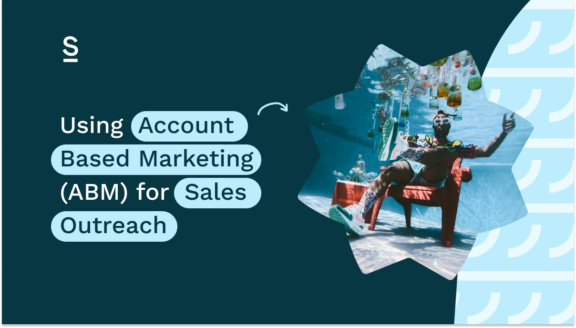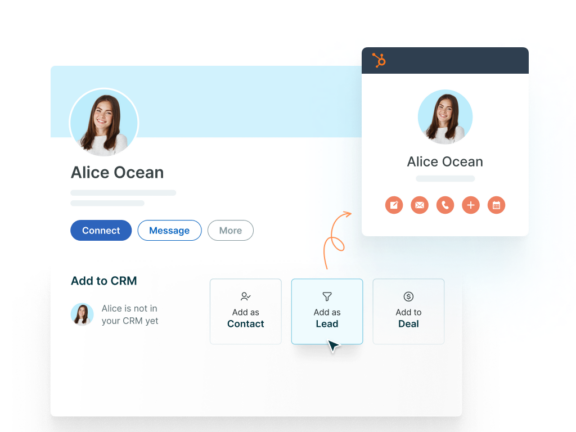Using Account-Based Marketing (ABM) for Sales Outreach

Account-Based Marketing (ABM) is a strategic approach that concentrates marketing and sales resources on a clearly defined set of target accounts within a market.
The idea of ABM is that by targeting a smaller amount of accounts, but with more personalization, you stand a greater chance of converting them.
In B2B sales, ABM is highly regarded due to its focused approach, which leads to higher conversion rates and more efficient use of resources.
Key highlights:
Understanding Account Based Marketing (ABM)
Your ABM strategy starts with setting clear, measurable goals. These objectives guide every phase of the ABM strategy ensuring every activity contributes to the overarching goals of the business.
Common goals in ABM strategies include:
- increasing account engagement
- improving conversion rates for targeted accounts
- and enhancing customer lifetime value.
Having well-defined goals ensures that the sales and marketing teams are aligned and focused on the same targets, which is what ABM revolves around.
But how do you identify target accounts for ABM?
After you’ve set your objectives, you come to a crucial point that will again influence every decision made afterwards: identifying the right target accounts.
Here you’re leveraging two primary resources: data analytics and your ideal customer profile. They will allow you to pinpoint companies and key decision-makers who are most likely to benefit from what you offer, and then convert.
👉 Use data to understand your ideal customer profile (ICP)
👉 Ensure your offering is aligned
👉 Identify target accounts
If you need help understanding your ideal customer profile, you might find the answers you’re looking for in this article:

Choosing The Right Channels For ABM
Diversifying content across different platforms is essential to engage your key accounts. Each channel offers unique opportunities to connect with target accounts and build a stronger business relationship. This could be LinkedIn if your offering is B2B, but it could also be any other platform your target account is frequenting.
If you did sufficient research when identifying your target accounts, the channels your target accounts are using should already be obvious.
But one example would be to target people in specific roles with Google Ads – you can target ads based on searches those people are likely to make. Reddit is another platform that is useful for targeting communities based on specific topics.
As a sales professional, you might be thinking, “but Google Ads and social aren’t my focus.” No, maybe not. But ABM revolves around the synergies of marketing and sales. It’s important that you’re aligned through a multi-touch, multi-channel strategy. Yes, the marketing team might be handling the ads, but it’s important that your LinkedIn outreach sends the right message at the right time. And for that, you need to be in sync with marketing.
Effective Channel Strategies for ABM:
LinkedIn: Essential for B2B engagement, offering precise targeting options.
Email Marketing: Personalized emails can nurture leads effectively.
Other socials: Engage with accounts in niche environments.
Paid ads: Place your offering exactly where your target is looking
Your marketing team can analyze the data from all these platforms, and tell you which is having the most impact. This also helps them create content that lands with the right audience.
If you’re looking for more info that dives into the specific of these channels, you might want to have a read through these:

Using Personalized Content and Messaging in ABM
The whole reason sales teams choose to focus on ABM is because it is proven to have higher conversion rates. But these conversion rates don’t just happen by magic.
Personalized content is key to ABM, addressing the specific needs, challenges, and interests of each target account.
Effective content types for ABM include case studies, whitepapers, customized videos, and targeted email campaigns, all designed to speak directly to the identified pain points and aspirations of the target accounts.
Content Customization Tips:
- Use insights and data to personalize content: personalization means more than just addressing the prospect by their first name. It’s about sending them a bespoke message that addresses their unique pain at just the right time.
- Develop bespoke case studies that reflect similar success stories: Case studies are a perfect way to prove the impact of your offering. Build custom case studies based on pain point, company size, industry, and the role of the individual in the buyer group you’re negotiating with.
- Tailor email campaigns to address specific business challenges: You can use tools like Salesloft and Outreach to build cadences that automate emails based on conditions and criteria. You can use them to address specific pain points with targeted messaging at exactly the right time. Build different cadences for different pain points, company sizes, and industries.
If you’re not already using Salesloft of Outreach, you can learn more about how to deploy them in the email strategy:
Measuring Performance and Adjusting Strategies
To refine your ABM strategy, you can use A/B testing and sales intelligence software to get a better understanding of what’s working, and why. There are data points along every stage of the journey, allowing you to know how people find you, what content is engaging them, and what action they take from there.
Tracking this data allows businesses to evaluate the success of their ABM campaigns and identify areas for improvement.
Key metrics to track in ABM:
Engagement Rates: Measures the effectiveness of content – the percentage of readers/viewers that engage/like/comment/share your content
Conversion Rates: Tracks the success rate of turning prospects into customers
Sales Cycle Length: Deploying ABM should enable you to shorten sales cycles. If you’re struggling to shorten the sales cycle, it could be a sign that your strategy needs some refining.
Building Relationships with Buying Committees
Given that B2B purchasing decisions often involve multiple stakeholders, it’s crucial to engage with all decision-makers within an account.
Creating content and messaging that resonates with each member of the buying committee supports sales in building these essential relationships. This approach ensures that all potential objections are addressed and that the value proposition is clearly communicated across the board.
Nurturing Relationships with Buying Committees
Once you’ve implemented account-based marketing, and you have high-value accounts, you need to nurture and maintain those relationships. It isn’t just your main point of contact you need to keep in touch with, you can foster relationships with everyone in the buying committee, which will ensure you aren’t forgotten when roles change. (and then, if they change companies, they might even advocate for your product/service there too!)
As with everything in ABM, you’re there to provide value. At every point of contact, you can make someone’s working life easier. Whether it’s by sharing relevant content, industry news, or even offering a training or refresher session on your product. Keeping interactions friendly and consultative rather than purely transactional are often more likely to improve sales outcomes, as well as increased customer satisfaction and retention.
Let’s wrap it up!
Account-Based Marketing (ABM) offers a refined, targeted approach to B2B sales.
Leveraging data analytics and personalized content, ABM facilitates engagement with key accounts across multiple channels, nurturing relationships with decision-makers.
Crucially, ABM requires tight alignment between sales and marketing teams to ensure a unified approach to target accounts. This alignment is critical for the success of ABM campaigns, as it ensures that both teams are working towards the same goals and using consistent messaging.

Add all your target accounts to your CRM with Surfe
Surfe connects LinkedIn to your CRM, allowing you to add contacts in one-click and source their professional, verified email address and mobile number.
FAQ about Implementing ABM For Sales:
What is the role of ABM in sales?
ABM facilitates a more focused approach to sales. It’s all about specifically targeting a smaller number of accounts instead of just throwing your content and outreach into the dark and hoping for the best. By providing personalized messaging to target accounts, sales teams have seen much higher conversion rates with ABM strategies.
How do you implement ABM in sales?
- Analyze and define target accounts
- Identify key decision makers within those accounts
- Develop a personalized approach for each account
- Continue nurturing the account, and maintain the relationship even after the deal has closed
How do you build an ABM team?
An ABM team should feature members of your sales team, as well as your marketing team. Everyone involved should have a deep understanding of your ICP, as well as what your offering can do for the account. Typical roles in an ABM team include the Strategy lead, Head of Sales for the team, a content creator, and a data analyst.
How many accounts should you target for ABM?
Small businesses can find success targeting 10-20 accounts, whereas larger businesses may be able to target hundreds. It’s typical to have around 50-500 target accounts. This depends on the needs of your business, the size of your team, and the industry you work in.


